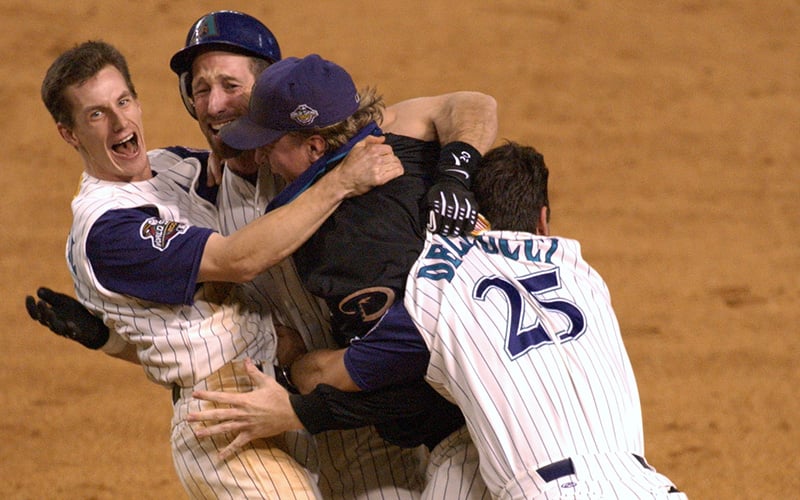
It was a short, challenging but successful road the Arizona Diamondbacks took to the 2001 World Series. The backdrop of 9/11 made it an emotional one. (Photo by MIKE NELSON/AFP via Getty Images)
This is the first in a series of stories looking at the Arizona Diamondbacks’ World Series run.
PHOENIX – Before the Arizona Diamondbacks won the 2001 World Series, before they stunned a world still reeling from the 9/11 attacks and captivated hearts by going toe-toe with the highly-favored New York Yankees, there was a crystallizing moment.
It was 1976, and Jerry Colangelo, the owner of the Phoenix Suns, stood on the floor of the Boston Garden, taking in the NBA Finals. The Suns were in their eighth NBA season, and had just won their first Western Conference Championship.
Colangelo did not expect it to be the last time he’d witness what a sports franchise could mean to the Valley, which at the time had only one professional team. He expected the Suns to continue to compete for championships for years to come. But while the Suns regularly made the NBA playoffs over the next several seasons, they didn’t reach the Finals again until 1993.
The lesson learned? If a championship window opens, you need to go for it all, because you never know how quickly that window will close.
Twenty five years later, Colangelo, now also the owner of the Diamondbacks, went for it on the diamond, and the D-Backs beat the Yankees in a dramatic seven games to win the club’s first (and still only) World Series. From an expansion team in the desert to a championship in barely four years, the D-Backs’ magical trip to the Fall Classic is still considered one of Arizona’s finest sporting achievements.
Arizona almost loses baseball
Before Phoenix was awarded an expansion team in 1995, baseball appeared to be on the verge of abandoning the state.
In 1990, the Cleveland Indians announced they would no longer play their spring training games in Tucson and would be moving to Florida. At the time, that would have left only seven teams in the Cactus League.
After Cleveland announced its move, rumors began circulating that the Chicago Cubs would also be relocating their spring training facilities.
Before Phoenix sports executives could even think about making an attempt at an expansion franchise, they had to save the Cactus League.
“Spring training is all about getting ready for the season,” said Joe Garagiola Jr., former general manager of the Diamondbacks. “And there’s a point where if there just aren’t enough teams out here to conduct meaningful spring training … Reluctantly, we will have to go to Florida.”
Ultimately, legislature was enacted to help improve facilities in the state, and MLB teams began coming back. Today, 15 teams compete every spring in Arizona.
Arizona’s willingness to save the Cactus League proved the region’s love for baseball and helped set the foundation for Phoenix’s run at a franchise a few years later.
The Diamondbacks are born
On Aug. 12, 1994, the MLB Players Association went on strike, halting the season in the dog days of August.
On Sep. 14, after rounds of unsuccessful negotiations, then commissioner Bud Selig canceled the remainder of the regular season and the postseason. It was only the second time in history the World Series had not been played, the other being in 1904.
It was one of the darkest days in baseball history. Former Blue Jays pitcher Dave Stewart told USA Today Sports in 2014 that it was one of the most embarrassing moments in MLB history.
Needless to say, baseball’s popularity around the country plummeted.
In Arizona, however, enthusiasm for sports was riding high. The Suns had just made their second NBA Finals appearance in 1993. In March 1995, Phoenix was awarded an expansion MLB franchise. In just one year, the team received 43,000 season ticket deposits.
After seeing the success the Suns had throughout the 1980s and ‘90s, there was buzz around another Colangelo-led team.
Buck Showalter, the former Yankees manager, was named the D-Backs’ first manager in 1996, two years before the team began play.
In 1997, the D-Backs signed Jay Bell as the team’s first player, and the expansion draft took place the next day in the Phoenix Civic Center.
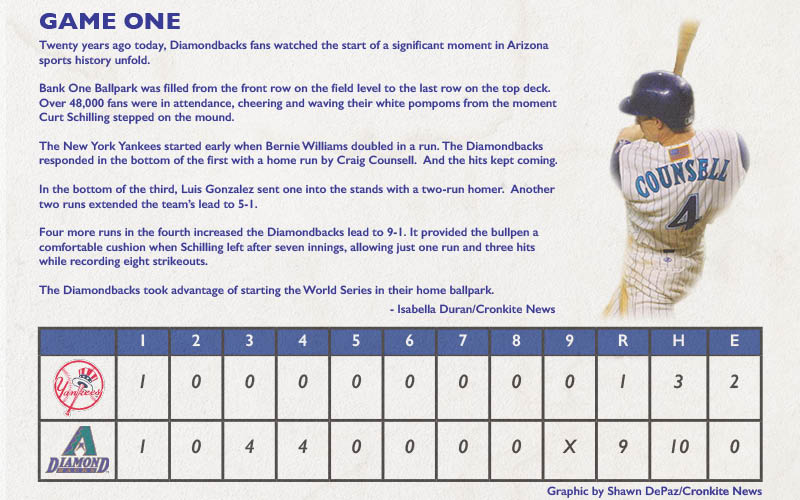
At the beginning
The Diamondbacks began play in 1998, losing 9-2 to the Colorado Rockies on Opening Day. As many expansion teams do, they struggled out of the gate, going 65-97 in their inaugural season.
The original plan, said former D-Backs president Rich Dozer, was to “take our lumps” over their first few seasons. At some point between when the plan was originally made and when the team began play, Colangelo changed his mind, and decided to take a more aggressive approach to the roster.
The D-Backs did not want to sacrifice development of their own players, but they felt they could balance an aggressive roster-building approach with player development.
“When you’re in a position to win, you go for it, because you don’t know when that chance is going to come around again,” Garagiola said.
After a tough first season, Arizona made a huge splash in free agency, signing pitcher Randy Johnson to a four-year contract worth $52.4 million. The Johnson and Bell acquisition a year earlier sent the league a clear message. The D-Backs may be the new team in the National League, but they will not be the doorstep of the league.
That same offseason, they traded for Luis Gonzalez and Tony Womack.
Gonzalez was coming off of a big season in Detroit, hitting 23 home runs and driving in 71 runs in 1998.
When looking at Gonzalez as a potential trade target, Garagiola compared the dimensions of Tiger Stadium in Detroit with Bank One Ballpark in Phoenix. While the dimensions in right-center and right field were similar to Detroit’s, Garagiola had a hunch that Gonzalez’ left-handed power could be effective in Phoenix.
The BOB, as the D-Backs’ home was then called, had the second-highest elevation in the league behind Coors Field in Denver. With the retractable roof controlling the weather coupled with the Valley’s elevation, Garagiola believed Gonzalez’ power numbers would only increase.
“I think this guy is probably good for between 35 and 40 home runs,” Garagiola said. “Oh, turns out I was off on the high side … because he had 57 home runs (in 2001).”
In eight seasons in Arizona, Gonzalez hit 224 home runs. Not only was he successful on the field, but Gonzo, as he is affectionately known, became and remains one of the more prominent Arizona sports figures.
“If you think about people who have performed in this town, but are also revered in this town and loved by everybody… It’s tough to go past Gonzo,” Dozer said.
He mentioned Gonzalez in the same echelon as Larry Fitzgerald and Charles Barkley, two Valley sports legends.
Womack, according to Garagiola, consistently demonstrated his ability to play the game at a high level during his time in Pittsburgh. In 1997 and 1998, Womack stole 118 bases for the Pirates.
In 1999, the Diamondbacks improved drastically, winning 100 games and taking the NL West by 14 games, before getting knocked out of the division series by the New York Mets. Making the postseason in just their second season was an accomplishment in itself, but the D-Backs’ front office wasn’t satisfied.
2000-2001
After a successful 1999 season, the D-Backs were once again poised for a postseason run. Heading into the All-Star break, they led the NL West by 3.5 games with a 51-37 record.
Like many contenders in July, they were looking to improve near the trade deadline. With Johnson leading the rotation, they acquired Curt Schilling from the Philadelphia Phillies to form a formidable one-two punch at the top of the rotation.
They sent four players to Philadelphia in the deal, including Travis Lee. At the time, Lee was considered one of the best young players in baseball.
“I mean, this guy was going to be somebody’s first baseman for 15 years,” Garagiola said. “So, to give him up, I mean, it was a big gamble.”
Even with the big trade before the deadline, the Diamondbacks struggled throughout the rest of the season. After the trade deadline, they went 27-30 and missed the postseason.
The organization decided to move on from Showalter after the season. With more veterans in the clubhouse, the team felt a managerial change of pace was needed.
“We felt we needed somebody a little bit more relaxed and that was basically the reason that we thought it was time to make the change,” Dozer said.
To take Showalter’s place, the D-Backs hired Bob Brenly, who had been around the organization and was well liked among the players in the clubhouse.
“(Brenly was) just the perfect person, we thought, when you had this team that was becoming much more of a veteran team,” Dozer said.
At one point in the offseason, Schilling, a Valley local who had played for Shadow Mountain High School, told Garagiola he had not felt like himself near the end of the 2000 season. Schilling had shoulder surgery during the 1999-2000 offseason, and he wasn’t able to go through a normal offseason of prep. As a result, Schilling said his body felt tired, and he wasn’t 100% over the last stretch of the 2000 season.
Heading into 2001, Schilling said he would have a full offseason and would look more like the pitcher the D-Backs had brought over from Philadelphia with much fanfare.
In 2001, the Diamondbacks made their way back to the top of the NL West, going 92-70. Womack stole 72 bases. Gonzales hit 57 home runs and tallied 142 RBI.
The Johnson-Schilling duo lived up to the hype. Johnson went 21-6 with a 2.49 ERA and 372 strikeouts, 11th most all-time in a single season. Schilling went 22-6 with a 2.98 ERA and 293 strikeouts. They combined for 506.2 innings and finished first and second in NL Cy Young voting, respectively.
In the NLDS, Arizona defeated the St. Louis Cardinals in five games. Womack hit a walk-off single to win the first playoff series in team history. In the NLCS, Atlanta awaited. The Braves had won five NL pennants in the ‘90s and had Greg Maddux and Tom Glavine leading their rotation.
For whatever reason, Garagiola said, the Diamondbacks had unquestioned confidence, and they also hit Maddux hard.
Maddux pitched well in the first game, allowing two runs and striking out five over seven innings. But Johnson had a better day, tossing a complete game shutout and striking out 11. Arizona won 2-0.
In the series-clinching Game 5, Arizona got to Maddux. He only lasted three innings, allowing six runs (four earned) and eight hits. Arizona won 11-4 to advance to the World Series.
2001 World Series
The 2001 Fall Classic is remembered for the roller coaster of emotions that swept across not only the Arizona fanbase, but the league and country as a whole.
The Yankees were playing in their fourth straight World Series, and this one was only six weeks removed from the September 11 terrorist attacks.
The first two games were in Arizona, and the D-Backs were brimming with confidence coming into the series. The Yankees’ Bernie Williams quickly introduced them to the Fall Classic with a double to take a 1-0 lead in the top of the first in Game 1.
When Garagiola thinks back on the 2001 postseason, a handful of specific hits come to mind.
The first, naturally, is Gonzalez’s bloop single in Game 7 that became perhaps the most iconic winning hit of any World Series. There is also Womack’s NLDS walk-off and game-tying double in that same game. But the hit that doesn’t get as much notice came after Williams gave the Yankees an early lead in Game 1.
“There was a little vibe that kind of went through the ballpark, that maybe the clock is about to strike 12 here,” Garagiola said.
Craig Counsell hit a home run to tie it in the bottom of the first, settling down a nervous home crowd.
“The whole thing, I think, kind of turned around,” Garagiola said of Counsell’s dinger.
“Now the feeling was, okay, you know what. This is a baseball game. They’re a baseball team, we’re a baseball team, let’s play.”
Arizona won the first two games at home, and had the opportunity to close out the Series with two wins in the Bronx.
After the Sept. 11 attacks, World Series baseball in New York was incredibly emotional.
Dozer remembers landing in New York and touring still-smoldering Ground Zero before the games.
“You can just see and smell the whole place, because it had only been less than two months before that it had happened,” Dozer said.
Before Game 3, President George Bush took the mound to throw out the first pitch. In that moment, as the field was lined with secret service agents and all rooting loyalties were pushed aside, a collective hush fell across the Stadium. Then came chills, and tears, and the loudest chants ever of “USA1 USA!” Baseball fans around the world would later say this was the first time they couldn’t hate the venerable New York Yankees.
“Twenty years later, I still struggle to put those feelings into words,” Garagiola said of those moments in New York, when it felt like so much more than just baseball.
Games 3, 4 and 5 were back-breaking for Arizona, as the D-Backs lost all three by one run each, and they blew back-to-back ninth-inning leads in Games 4 and 5, losing both in extra innings.
Back in Phoenix for Game 6, the D-Backs jumped all over Yankee pitchers Andy Pettitte and Jay Witasick, taking a 15-0 lead in the fourth inning before winning 15-2 in front of a raucous crowd eager for its first World Series trophy.
The drama flowed into the following night when, with a soft rain falling, the Diamondbacks got to Yankees reliever Mariano Rivera, the best closer of all time, scratching across two runs in a wacky ninth inning. With the score tied 2-2 and the bases loaded with one out, Gonzo’s soft single off Rivera sent Bell home and gave the D-Backs their first World Series.
The image of Bell jumping into Matt Williams’ arms after scoring the winning run has become one of the most iconic moments in Arizona sports history. Two players who had been with the team since its inception were now champions together.
“There’s just so many weird things that happened and it was so fitting to watch Jay Bell score the winning run and run right into Matt Williams’ arms,” Dozer said.
People who were a part of the 2001 team clearly love discussing the season and reliving the magic.
Along with the memories, the accolades live on as well. The Diamondbacks remain the fastest expansion team to win a championship in baseball history, and they defeated three Hall of Fame managers on the way. They beat Tony La Russa, Bobby Cox and Joe Torre.
“I have 1,000 memories about my time with the Diamondbacks,” Colangelo said. “It is something that is embedded in anyone who had anything to do with the D-Backs and it’s hard to say 20 years have gone by.”
In this series: Remembering the Diamondbacks' 2001 World Series

Journalists reflect on an emotional World Series
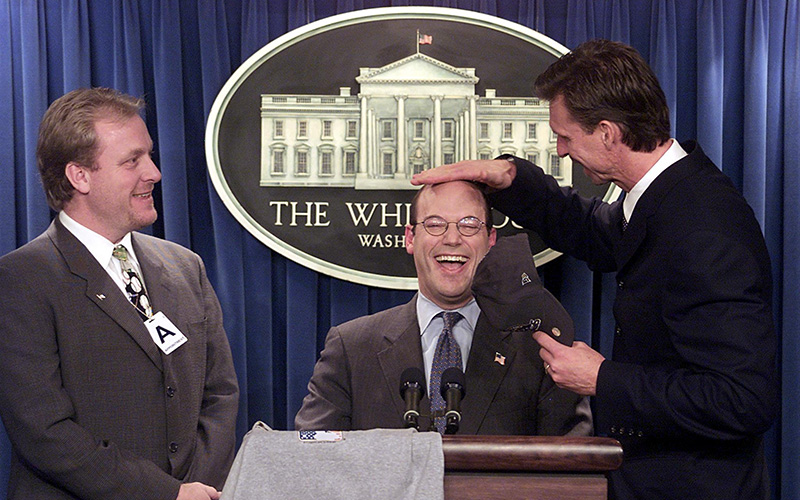
The Diamondbacks-Yankees series was about more than just baseball
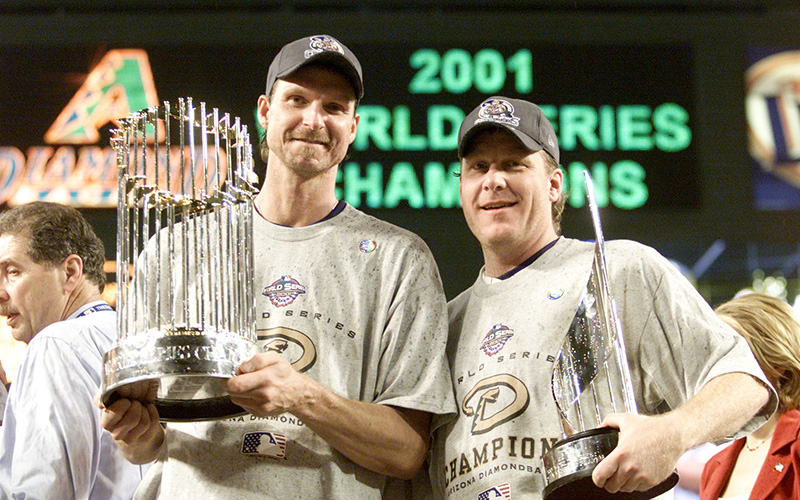
Trophies and rings and championships, oh my
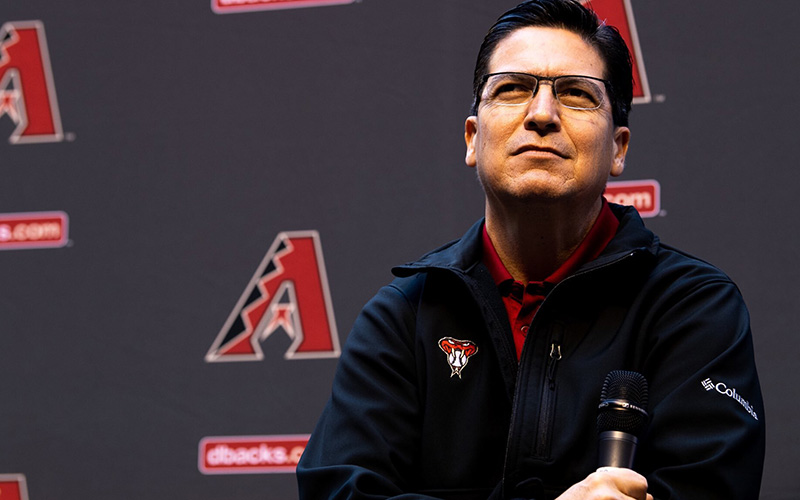
The Diamondbacks' World Series win impacted Hispanic community, too
